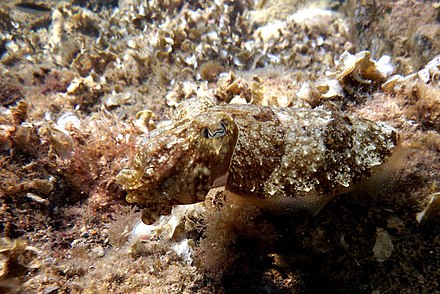Sepia (cephalopod)
Acanthosepion Rochebrune, 1884
Anomalosepia Khromov, 1987
Doratosepion Rochebrune, 1884
Hemisepius Steenstrup, 1875
Rhombosepion Rochebrune, 1884
Sepia Linnaeus, 1758
Sepia is a genus of cuttlefish in the family Sepiidae encompassing some of the best known and most common species. The cuttlebone is relatively ellipsoid in shape. The name of the genus is the Latinized form of the Ancient Greek σηπία, sēpía, cuttlefish.
All members of Sepia share certain characteristics. Among them are the presence of eight arms and two tentacles. Tentacles are retractable limbs used specifically to latch on to prey; the arms are used for holding and manipulating that prey, as well as for producing patterns of light and dark meant to distract that prey, but the tentacles serve no purpose other than to target and adhere to potential prey items. Once a prey item has been caught, the tentacles detach from it and have no other function.All members Sepia have two such tentacles in addition to their eight regular arms. The tentacles reside in sheaths that run below the eyes and behind the head, into the visceral mass. Here they are reserved as coiled, spring-loaded appendages, waiting to be sprung.
The species listed above with an asterisk (*) are questionable and need further study to determine if they are a valid species or a synonym. The question mark (?) indicates questionable placement within the genus.
A number of extinct species have been described from the Neogene of Europe, though many of these are likely synonyms.[4] They include:[4]


.jpg/440px-Sepia_latimanus_(Broadclub_cuttlefish).jpg)




